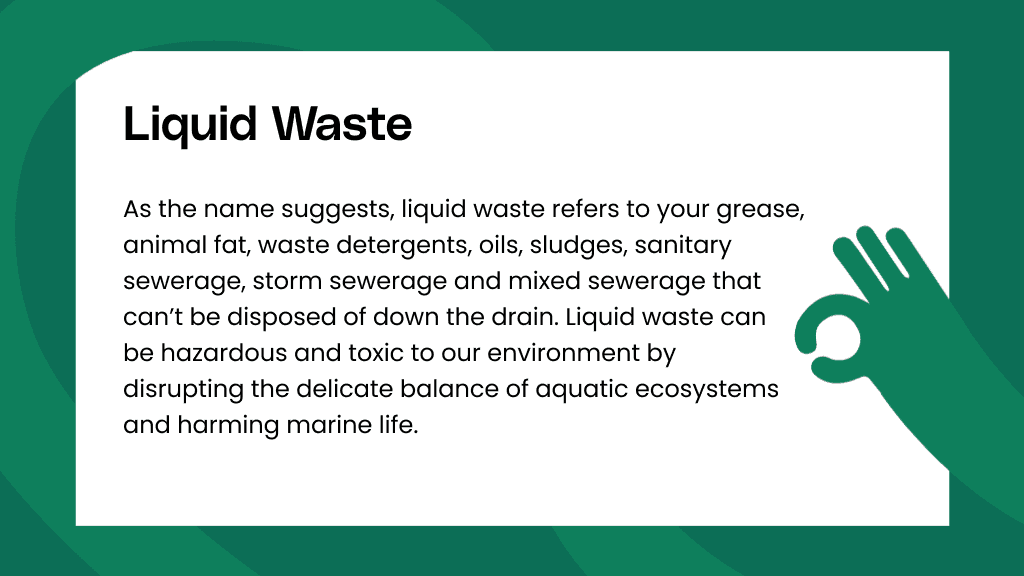The 9-Second Trick For Reclaim Waste
The 9-Second Trick For Reclaim Waste
Blog Article
Reclaim Waste Fundamentals Explained
Table of Contents3 Simple Techniques For Reclaim WasteReclaim Waste Can Be Fun For AnyoneThe Single Strategy To Use For Reclaim WasteNot known Facts About Reclaim WasteThe smart Trick of Reclaim Waste That Nobody is Talking About
Residential sewage waste refers to the waste and products from a residential septic container. The correct administration and disposal of domestic sewage waste need liquid waste to be moved to a sewage therapy plant where the proper techniques and devices are used to purify and dispose of waste.
Industrial waste commonly consists of potential risks, such as combustible materials or a mixture of fluid and solid waste items, and requires an advanced and in-depth disposal process. The disposal of industrial waste typically involves the purification of waste before transport to make certain risk-free and appropriate disposal. Industrial waste is produced from by-products and overflow of industrial procedures and production.
This kind of waste can not use the same sewer administration transportation or procedures as septic or commercial fluids. The hazardous waste management procedure needs the inspection and screening of fluid waste before it undertakes the disposal procedure (liquid waste disposal melbourne). Overflow waste is the liquid waste that originates from drainage and excess stormwater in very inhabited locations or cities
Runoff waste can trigger contamination and flooding if not dealt with properly. Ensuring proper waste management can prevent catastrophes and decrease environmental injury.
4 Easy Facts About Reclaim Waste Explained
Call PROS Services today to find out about our waste monitoring and disposal services and the correct methods to take care of the liquid waste you create.
(https://writeablog.net/reclaimwaste1/reclaiming-resources-a-comprehensive-guide-to-industrial-wastewater-treatment)This supposed 'wastewater' is not just an essential source but, after treatment, will be released to our land, waterways or the sea. Made use of water from bathrooms, showers, baths, cooking area sinks, washings and commercial processes is known as wastewater.

water made use of to cool machinery or clean plant and tools). Stormwater, a kind of wastewater, is runoff that streams from agricultural and metropolitan locations such as roofings, parks, yards, roadways, courses and gutters right into stormwater drains pipes, after rainfall. Stormwater streams neglected straight to neighborhood creeks or rivers, ultimately reaching the sea.
Not known Details About Reclaim Waste
In Queensland, most wastewater is treated at sewage therapy plants. Wastewater is delivered from residential or industrial websites via a system of sewage systems and pump terminals, known as sewerage reticulation, to a sewage treatment plant.
The Department of Natural Resources advises neighborhood governments about managing, operating and maintaining sewage systems and therapy plants. In unsewered areas, city governments may call for homeowners to mount specific or household sewer therapy systems to deal with residential wastewater from bathrooms, kitchen areas, restrooms and washings. The Department of Natural Resources authorises the use of family systems when they are shown to be efficient.
In some brand-new neighborhoods, treatment of some stormwater to remove trash, sand and gravel has begun making use of gross pollutant catches. Wastewater therapy happens in 4 stages: Gets rid of solid issue.
Wastewater then streams into big tanks where solids settle and are gotten rid of as sludge. Oil and scum are skimmed from the surface area. Utilizes small living organisms understands as micro-organisms to damage down and eliminate continuing to be liquified wastes and fine bits. Micro-organisms and wastes are incorporated in the sludge. Gets rid of nitrogen and phosphorus nutrients that might cause algal flowers in our waterways and threaten aquatic life.
8 Simple Techniques For Reclaim Waste
Nutrient removal is not offered at all sewer treatment plants since it calls for costly over here specialist tools. Clear fluid effluent produced after treatment may still include disease-causing micro-organisms - liquid waste removal.

The majority of wastewater streams into the sewage system. Under the Act, neighborhood governments administer authorizations and licences for environmentally appropriate tasks (ERAs) including wastewater launches that might have a neighborhood impact.
Some Known Factual Statements About Reclaim Waste
Monitoring supplies valid info concerning water high quality and can confirm that permit problems are being satisfied. The information acquired through tracking supplies the basis for making water high quality choices.
Report this page